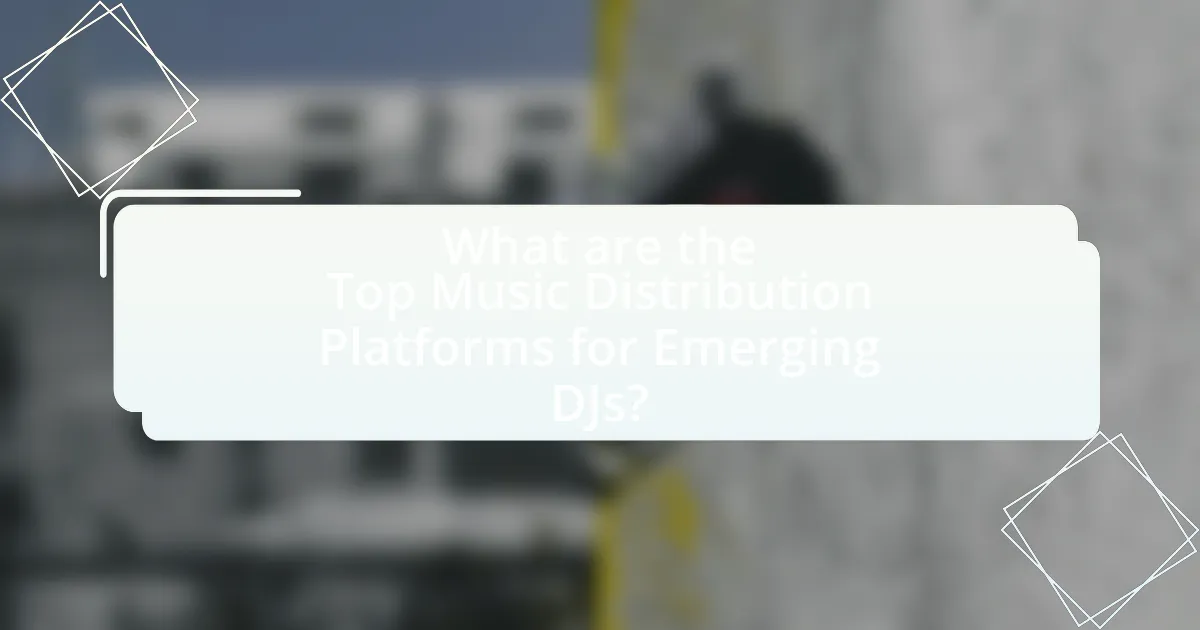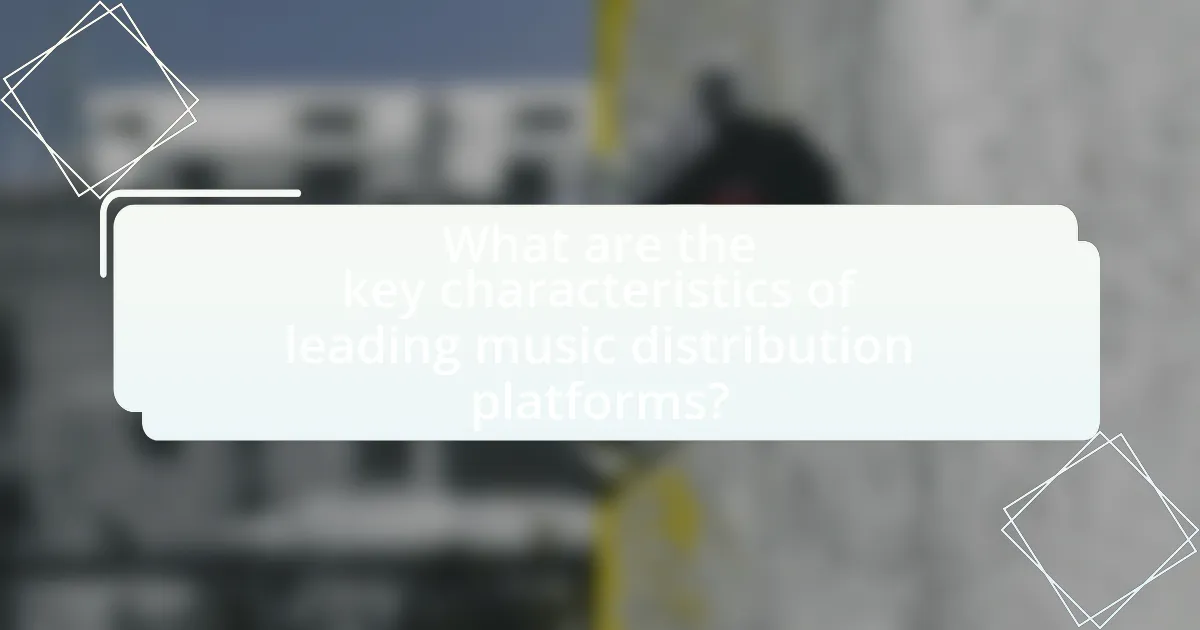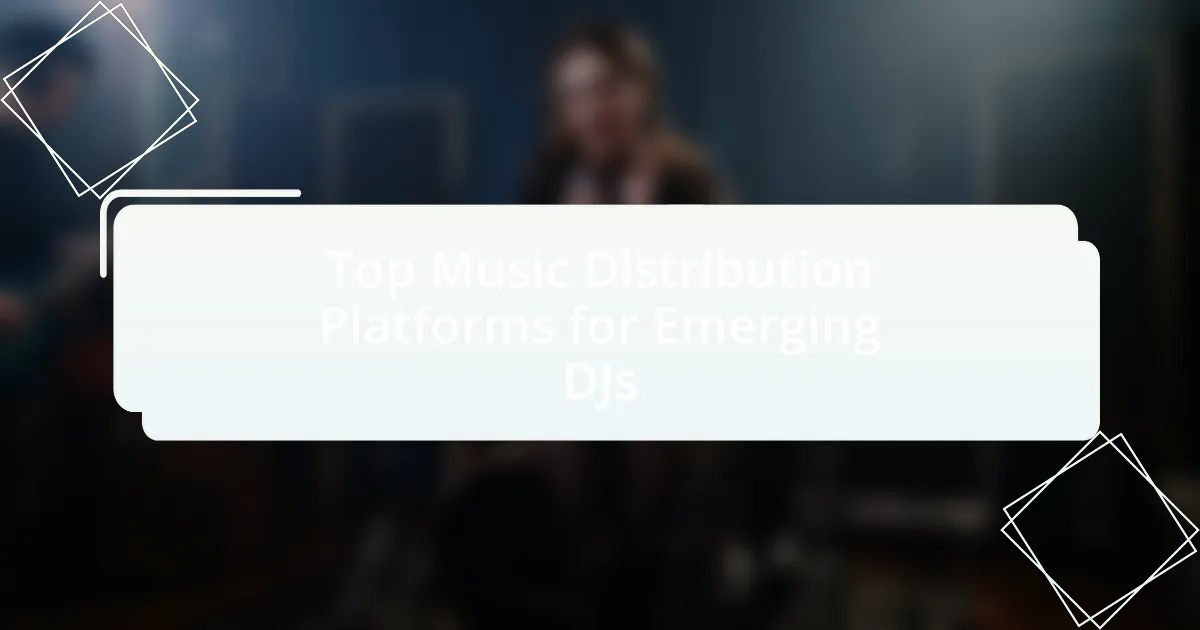The article focuses on the top music distribution platforms for emerging DJs, highlighting key services offered by DistroKid, TuneCore, and CD Baby. It outlines how these platforms support DJs through tools for music distribution, marketing, and audience engagement, emphasizing essential features such as global reach, royalty tracking, and user-friendly interfaces. Additionally, the article discusses the importance of effective distribution for career growth, the impact of pricing models on financial outcomes, and best practices for maximizing platform potential. It also addresses genre-specific needs and common pitfalls to avoid, providing a comprehensive overview for DJs seeking to enhance their visibility and success in the music industry.

What are the Top Music Distribution Platforms for Emerging DJs?
The top music distribution platforms for emerging DJs include DistroKid, TuneCore, and CD Baby. DistroKid allows artists to upload unlimited music for a yearly fee and distributes to over 150 platforms, making it cost-effective for new DJs. TuneCore offers a pay-per-release model and provides detailed sales reports, which is beneficial for tracking performance. CD Baby is known for its one-time fee per release and offers additional services like physical distribution and sync licensing, catering to a wide range of emerging artists. These platforms are widely recognized in the industry for their accessibility and comprehensive services tailored to independent musicians.
How do these platforms support emerging DJs?
Music distribution platforms support emerging DJs by providing tools for music distribution, marketing, and audience engagement. These platforms, such as DistroKid, TuneCore, and CD Baby, enable DJs to upload their tracks to major streaming services like Spotify and Apple Music, ensuring wider reach and visibility. Additionally, they often offer promotional resources, such as social media marketing tools and analytics, which help DJs understand their audience and optimize their promotional strategies. For instance, DistroKid allows artists to keep 100% of their royalties, incentivizing emerging DJs to distribute their music without financial barriers. This combination of distribution capabilities and marketing support is crucial for the growth and success of new DJs in the competitive music industry.
What features are essential for music distribution platforms?
Essential features for music distribution platforms include global reach, royalty tracking, user-friendly interface, and analytics tools. Global reach ensures that music is available on major streaming services worldwide, maximizing audience exposure. Royalty tracking allows artists to monitor earnings accurately, which is crucial for financial transparency. A user-friendly interface simplifies the upload and management process for artists, making it accessible even for those with limited technical skills. Analytics tools provide insights into listener demographics and engagement, enabling artists to tailor their marketing strategies effectively. These features collectively enhance the distribution experience for emerging DJs, facilitating their growth in the competitive music industry.
How do these features enhance the visibility of emerging DJs?
The features of music distribution platforms enhance the visibility of emerging DJs by providing them with access to a wider audience through digital streaming services and social media integration. These platforms often include tools for analytics, allowing DJs to track listener engagement and optimize their promotional strategies. For instance, platforms like Spotify and SoundCloud enable emerging DJs to showcase their tracks to millions of users, increasing their chances of being discovered. Additionally, features such as playlist placements and algorithm-driven recommendations further amplify their reach, as evidenced by the fact that tracks featured on popular playlists can see a significant increase in streams, sometimes exceeding thousands of plays within days.
Why is music distribution important for emerging DJs?
Music distribution is crucial for emerging DJs because it enables them to reach a wider audience and monetize their work effectively. By utilizing music distribution platforms, DJs can ensure their tracks are available on major streaming services and digital stores, which increases visibility and potential fan engagement. For instance, platforms like DistroKid and TuneCore allow artists to distribute their music globally, providing access to millions of listeners. This accessibility is essential for emerging DJs to build their brand, gain recognition, and ultimately grow their careers in a competitive industry.
What role does distribution play in an artist’s career growth?
Distribution plays a crucial role in an artist’s career growth by ensuring their music reaches a wider audience across various platforms. Effective distribution allows artists to make their work accessible on streaming services, digital stores, and social media, which can significantly increase their visibility and fan base. For instance, according to a report by the International Federation of the Phonographic Industry (IFPI), artists who utilize digital distribution channels can achieve up to 80% of their revenue from streaming platforms, highlighting the financial impact of proper distribution. Additionally, successful distribution strategies can lead to opportunities for collaborations, live performances, and increased engagement with fans, further propelling an artist’s career trajectory.
How can effective distribution impact an emerging DJ’s reach?
Effective distribution significantly enhances an emerging DJ’s reach by ensuring their music is accessible across multiple platforms and audiences. When a DJ utilizes effective distribution channels, their tracks can be streamed or downloaded on popular platforms like Spotify, Apple Music, and SoundCloud, which collectively have millions of active users. This broadens the potential listener base, increases visibility, and facilitates engagement with fans. For instance, according to a 2021 report by the International Federation of the Phonographic Industry, digital music revenues grew by 19.9%, highlighting the importance of digital distribution in reaching wider audiences. Thus, effective distribution not only amplifies an emerging DJ’s presence but also plays a crucial role in their overall success in the competitive music industry.

What are the key characteristics of leading music distribution platforms?
Leading music distribution platforms are characterized by user-friendly interfaces, extensive distribution networks, and robust analytics tools. User-friendly interfaces allow artists to easily upload and manage their music, while extensive distribution networks ensure that tracks reach major streaming services like Spotify, Apple Music, and Amazon Music. Robust analytics tools provide artists with insights into their audience demographics, streaming statistics, and revenue tracking, enabling informed decision-making. For instance, platforms like DistroKid and TuneCore are known for their straightforward processes and comprehensive reporting features, which enhance the overall experience for emerging DJs.
How do pricing models vary among these platforms?
Pricing models among music distribution platforms for emerging DJs vary significantly, primarily in terms of upfront fees, revenue sharing, and subscription options. For instance, platforms like DistroKid charge an annual fee for unlimited uploads, while TuneCore operates on a per-release basis, requiring separate payments for singles and albums. Additionally, some platforms, such as CD Baby, take a percentage of sales, typically around 9% to 15%, which contrasts with others that offer flat-rate pricing without taking a cut from earnings. This diversity in pricing structures allows DJs to choose a platform that aligns with their distribution needs and financial strategy, reflecting the competitive landscape of music distribution services.
What are the common pricing structures available?
Common pricing structures available for music distribution platforms include flat fee, percentage-based, and tiered pricing models. Flat fee structures charge a fixed amount for distribution services, regardless of sales volume, making it predictable for artists. Percentage-based models take a commission from the revenue generated by the music, typically ranging from 10% to 30%, aligning the platform’s earnings with the artist’s success. Tiered pricing offers different levels of service at varying price points, allowing artists to choose based on their needs and budget. These structures are designed to accommodate the diverse financial situations of emerging DJs and help them effectively distribute their music.
How do these pricing models affect emerging DJs financially?
Pricing models significantly impact emerging DJs financially by determining their revenue share and upfront costs associated with music distribution. For instance, platforms that charge a flat fee for distribution allow DJs to retain a higher percentage of their earnings from sales and streaming, which can be crucial for those just starting out. Conversely, platforms that take a percentage of earnings may reduce the overall income for emerging DJs, especially if their music does not gain substantial traction. According to a 2021 report by the International Federation of the Phonographic Industry, independent artists often earn only 12% of the revenue generated from streaming, highlighting the financial challenges posed by certain pricing structures. Thus, the choice of distribution platform and its pricing model can directly influence the financial viability and growth potential for emerging DJs.
What distribution platforms are most popular among emerging DJs?
The most popular distribution platforms among emerging DJs are DistroKid, TuneCore, and CD Baby. DistroKid is favored for its fast distribution and affordable pricing, allowing artists to upload unlimited tracks for a yearly fee. TuneCore offers extensive global reach and detailed sales reports, making it a strong choice for those focused on analytics. CD Baby is known for its comprehensive services, including physical distribution and sync licensing opportunities. These platforms collectively dominate the market due to their user-friendly interfaces, competitive pricing, and robust support for independent artists.
What are the unique selling points of each platform?
The unique selling points of top music distribution platforms for emerging DJs include tailored services, user-friendly interfaces, and extensive reach. For instance, DistroKid offers unlimited uploads for a flat annual fee, making it cost-effective for frequent releases. TuneCore provides detailed analytics and a robust marketing toolkit, empowering artists to track their performance and promote their music effectively. CD Baby stands out with its physical distribution options, allowing artists to sell CDs and vinyl alongside digital releases. Additionally, Amuse offers a free distribution model with the option for artists to sign with a label, providing both independence and support. Each platform’s unique features cater to different needs, enhancing the overall experience for emerging DJs.
How do user experiences differ across these platforms?
User experiences differ across music distribution platforms for emerging DJs primarily in terms of user interface, accessibility, and support services. For instance, platforms like DistroKid offer a straightforward, user-friendly interface that allows DJs to upload music quickly, while others like TuneCore may have a more complex process that requires additional steps for distribution. Accessibility varies as well; some platforms provide instant distribution to multiple streaming services, whereas others may have longer processing times. Additionally, support services differ significantly; platforms such as CD Baby offer extensive customer support and resources for artists, while others may provide limited assistance. These differences impact how emerging DJs navigate the distribution process and manage their music careers.

What should emerging DJs consider when choosing a distribution platform?
Emerging DJs should consider the platform’s reach and the distribution channels it offers. A wide reach ensures that their music is available on major streaming services like Spotify, Apple Music, and others, which is crucial for gaining visibility. Additionally, DJs should evaluate the platform’s royalty rates and fees, as these can significantly impact their earnings. For instance, platforms like DistroKid offer unlimited uploads for a flat annual fee, while others may take a percentage of earnings. Furthermore, the ease of use and the support provided by the platform are important; platforms that offer user-friendly interfaces and responsive customer service can enhance the distribution experience. Lastly, emerging DJs should look for platforms that provide marketing tools or promotional support, as these features can help in building their brand and reaching a larger audience.
How do genre-specific needs influence platform selection?
Genre-specific needs significantly influence platform selection by determining the features and audience engagement required for effective music distribution. For instance, electronic dance music (EDM) artists may prioritize platforms that cater to DJ mixes and live sets, such as SoundCloud or Mixcloud, which allow for longer tracks and community interaction. In contrast, hip-hop artists might choose platforms like DistroKid or TuneCore that facilitate quick releases and offer analytics to track listener demographics. Research indicates that artists who align their distribution choices with their genre’s characteristics experience higher engagement rates and better audience reach, as evidenced by a 2021 study from the International Journal of Music Business Research, which found that genre alignment in platform selection correlates with a 30% increase in listener interaction.
What platforms cater specifically to electronic music DJs?
Platforms that cater specifically to electronic music DJs include Beatport, SoundCloud, and Traxsource. Beatport is renowned for its extensive catalog of electronic music and is a primary source for DJs to purchase and download tracks. SoundCloud allows DJs to share their mixes and tracks, fostering a community of listeners and artists. Traxsource specializes in house music and offers a platform for DJs to discover and purchase tracks tailored to their genre. These platforms are essential for electronic music DJs to access, distribute, and promote their work effectively.
How can DJs assess the compatibility of a platform with their music style?
DJs can assess the compatibility of a platform with their music style by analyzing the platform’s genre focus, audience demographics, and distribution features. For instance, platforms like SoundCloud cater to a wide range of genres, making them suitable for diverse music styles, while others like Beatport specialize in electronic music, which may align better with DJs focused on that genre. Additionally, examining user engagement metrics and community feedback on the platform can provide insights into how well the platform supports specific music styles. Research indicates that platforms with strong genre-specific communities often yield better audience reach and engagement for DJs, reinforcing the importance of aligning music style with platform characteristics.
What are the common pitfalls to avoid when using music distribution platforms?
Common pitfalls to avoid when using music distribution platforms include neglecting to read the terms and conditions, which can lead to unexpected fees or loss of rights. Many artists fail to understand the revenue split, often resulting in lower earnings than anticipated. Additionally, not properly preparing metadata can hinder discoverability on streaming services, impacting overall reach. Lastly, overlooking promotional tools provided by the platform can limit audience engagement and growth. These pitfalls can significantly affect an artist’s success and financial return in the competitive music industry.
What mistakes do emerging DJs often make with distribution?
Emerging DJs often make the mistake of underestimating the importance of selecting the right distribution platform for their music. Many new DJs fail to research and compare various distribution services, which can lead to suboptimal reach and revenue. For instance, some platforms may charge high fees or offer limited access to streaming services, negatively impacting the DJ’s ability to monetize their work effectively. Additionally, emerging DJs frequently overlook the significance of understanding the terms and conditions of distribution agreements, which can result in losing rights to their music or facing unexpected costs.
How can DJs ensure they are maximizing their platform’s potential?
DJs can maximize their platform’s potential by actively engaging with their audience and utilizing analytics to inform their strategies. Engaging with listeners through social media, live streams, and interactive content fosters a loyal fan base, which is crucial for growth. Additionally, platforms like Spotify and SoundCloud provide analytics that reveal listener demographics and preferences, enabling DJs to tailor their content effectively. According to a 2021 report by MIDiA Research, artists who engage with their audience on multiple platforms see a 30% increase in fan retention, demonstrating the importance of audience interaction in maximizing platform potential.
What best practices should emerging DJs follow for effective music distribution?
Emerging DJs should prioritize using multiple digital distribution platforms to maximize their reach and audience engagement. By distributing music through platforms like DistroKid, TuneCore, and CD Baby, DJs can ensure their tracks are available on major streaming services such as Spotify, Apple Music, and Amazon Music. This multi-platform approach increases visibility and potential revenue streams.
Additionally, DJs should focus on building a strong online presence through social media and music promotion channels. Engaging with fans and leveraging platforms like SoundCloud and Bandcamp can create a loyal listener base and facilitate direct feedback. According to a 2021 report by the International Federation of the Phonographic Industry, digital music revenues grew by 19.9%, highlighting the importance of effective online distribution strategies for emerging artists.
Finally, maintaining high-quality audio standards and consistent branding across all platforms is crucial. This ensures that the music is not only professionally presented but also aligns with the DJ’s artistic identity, which can enhance listener retention and attract new fans.
How can DJs leverage social media alongside distribution platforms?
DJs can leverage social media alongside distribution platforms by using social media to promote their music and engage with their audience while utilizing distribution platforms to ensure their tracks reach a wider audience. Social media platforms like Instagram, Facebook, and TikTok allow DJs to share snippets of their music, behind-the-scenes content, and live performances, creating a personal connection with fans. This engagement can drive traffic to their music on distribution platforms such as Spotify, Apple Music, and SoundCloud, where listeners can access full tracks. According to a study by the International Federation of the Phonographic Industry (IFPI), 70% of music listeners discover new music through social media, highlighting its effectiveness in promoting music. By integrating social media marketing with music distribution, DJs can enhance their visibility and increase their listener base.
What strategies can enhance the success of music releases?
Effective strategies to enhance the success of music releases include leveraging social media marketing, engaging with fans through live performances, and utilizing data analytics for targeted promotions. Social media platforms like Instagram and TikTok have proven to significantly increase visibility; for instance, a study by the International Federation of the Phonographic Industry (IFPI) found that 70% of music consumers discover new music through social media. Engaging with fans through live performances, whether virtual or in-person, fosters a deeper connection and can lead to increased sales and streaming numbers. Additionally, using data analytics tools allows artists to identify their audience demographics and tailor their marketing efforts accordingly, which can lead to more effective promotional campaigns.

Leave a Reply